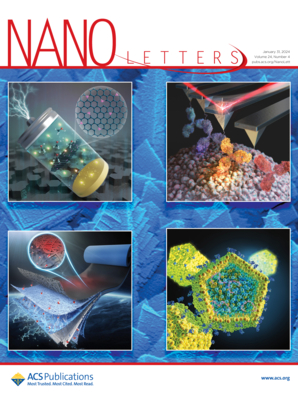Advancing Self-Powered Devices with Novel MXene/Graphene Oxide/Siloxene Frameworks on Textiles: Bridging Chemistry and Sustainability
IF 9.6
1区 材料科学
Q1 CHEMISTRY, MULTIDISCIPLINARY
引用次数: 0
Abstract
Recent advancements in self-charging power devices highlight the potential of dielectric nanofillers in polymer matrixes to improve the performance of microsupercapacitor–triboelectric nanogenerator (TENG) integrated devices. However, achieving homogeneous dispersion of nanofillers into polymer matrixes remains a key bottleneck, often leading to inconsistent performance, reduced stability, and lower energy efficiency. This work presents an innovative chemical functionalization strategy covalently knitting MXene/graphene oxide (GO)/siloxene and MXene/reduced GO/siloxene networks into textile substrates, resulting in a consistent output performance and the development of a durable device. The single-electrode TENG delivered an output voltage of 380 V, a current density of 6.3 μA/cm2, a power density of 627 μW/cm2, and the transfer of 0.55 ± 0.03 μC of charge. The integrated device charged a voltage of 2.4 V after 110 s of continuous hand tapping, powering smart electronics. These results showcase the potential of chemically engineered heterostructures to address longstanding challenges in self-charging devices.

用新型MXene/氧化石墨烯/硅氧烷框架在纺织品上推进自供电装置:桥接化学和可持续性
自充电电源器件的最新进展突出了聚合物基体中介电纳米填料在提高微超级电容器-摩擦电纳米发电机(TENG)集成器件性能方面的潜力。然而,实现纳米填料在聚合物基体中的均匀分散仍然是一个关键的瓶颈,通常会导致性能不一致、稳定性降低和能效降低。这项工作提出了一种创新的化学功能化策略,将MXene/氧化石墨烯(GO)/硅氧烷和MXene/还原氧化石墨烯/硅氧烷网络共价编织到纺织基材中,从而实现一致的输出性能和耐用设备的开发。单电极TENG输出电压为380 V,电流密度为6.3 μA/cm2,功率密度为627 μW/cm2,电荷转移量为0.55±0.03 μC。该集成设备在持续用手轻敲110秒后充电2.4 V电压,为智能电子设备供电。这些结果显示了化学工程异质结构在解决自充电设备中长期存在的挑战方面的潜力。
本文章由计算机程序翻译,如有差异,请以英文原文为准。
求助全文
约1分钟内获得全文
求助全文
来源期刊

Nano Letters
工程技术-材料科学:综合
CiteScore
16.80
自引率
2.80%
发文量
1182
审稿时长
1.4 months
期刊介绍:
Nano Letters serves as a dynamic platform for promptly disseminating original results in fundamental, applied, and emerging research across all facets of nanoscience and nanotechnology. A pivotal criterion for inclusion within Nano Letters is the convergence of at least two different areas or disciplines, ensuring a rich interdisciplinary scope. The journal is dedicated to fostering exploration in diverse areas, including:
- Experimental and theoretical findings on physical, chemical, and biological phenomena at the nanoscale
- Synthesis, characterization, and processing of organic, inorganic, polymer, and hybrid nanomaterials through physical, chemical, and biological methodologies
- Modeling and simulation of synthetic, assembly, and interaction processes
- Realization of integrated nanostructures and nano-engineered devices exhibiting advanced performance
- Applications of nanoscale materials in living and environmental systems
Nano Letters is committed to advancing and showcasing groundbreaking research that intersects various domains, fostering innovation and collaboration in the ever-evolving field of nanoscience and nanotechnology.
 求助内容:
求助内容: 应助结果提醒方式:
应助结果提醒方式:


